Conditional deletion of Sox17 reveals complex effects on uterine adenogenesis and function
- PMID: 27102016
- PMCID: PMC5521196
- DOI: 10.1016/j.ydbio.2016.04.010
Conditional deletion of Sox17 reveals complex effects on uterine adenogenesis and function
Abstract
The importance of canonical Wnt signaling to murine uterine development is well established. Mouse models in which uterine-specific Wnt ligands, β-catenin, or Lef1 are disrupted result in failure of postnatal endometrial gland development. Sox17 is a transcription factor characterized in numerous tissues as an antagonist of Wnt signaling. Thus, we hypothesized that conditional ablation of Sox17 would lead to hyperproliferation of endometrial glands in mice. Contrary to our prediction, disruption of Sox17 in epithelial and stromal compartments led to inhibition of endometrial adenogenesis and a loss of reproductive capacity. Epithelium-specific Sox17 disruption resulted in normal adenogenesis although reproductive capacity remained impaired. These findings suggest that non-epithelial, Sox17-positive cells are necessary for adenogenesis and that glands require Sox17 to properly function. To our knowledge, these findings are the first to implicate Sox17 in endometrial gland formation and reproductive success. The data presented herein underscore the importance of studying Sox17 in uterine homeostasis and function.
Keywords: Adenogenesis; Development; Endometrial glands; Mouse model; Sox17; Uterus.
Copyright © 2016 Elsevier Inc. All rights reserved.
Conflict of interest statement
The authors have no competing financial interests.
Figures
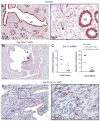
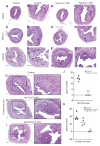

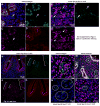
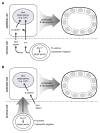
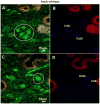
Similar articles
-
SOX17 regulates uterine epithelial-stromal cross-talk acting via a distal enhancer upstream of Ihh.Nat Commun. 2018 Oct 24;9(1):4421. doi: 10.1038/s41467-018-06652-w. Nat Commun. 2018. PMID: 30356064 Free PMC article.
-
Wnt/β-catenin signalling regulates Sox17 expression and is essential for organizer and endoderm formation in the mouse.Development. 2013 Aug;140(15):3128-38. doi: 10.1242/dev.088765. Epub 2013 Jul 3. Development. 2013. PMID: 23824574
-
Sox17 modulates Wnt3A/beta-catenin-mediated transcriptional activation of the Lef-1 promoter.Am J Physiol Lung Cell Mol Physiol. 2010 Nov;299(5):L694-710. doi: 10.1152/ajplung.00140.2010. Epub 2010 Aug 27. Am J Physiol Lung Cell Mol Physiol. 2010. PMID: 20802155 Free PMC article.
-
Uterine glands: development, function and experimental model systems.Mol Hum Reprod. 2013 Sep;19(9):547-58. doi: 10.1093/molehr/gat031. Epub 2013 Apr 25. Mol Hum Reprod. 2013. PMID: 23619340 Free PMC article. Review.
-
Developmental biology of uterine glands.Biol Reprod. 2001 Nov;65(5):1311-23. doi: 10.1095/biolreprod65.5.1311. Biol Reprod. 2001. PMID: 11673245 Review.
Cited by
-
Long-term, hormone-responsive organoid cultures of human endometrium in a chemically defined medium.Nat Cell Biol. 2017 May;19(5):568-577. doi: 10.1038/ncb3516. Epub 2017 Apr 10. Nat Cell Biol. 2017. PMID: 28394884 Free PMC article.
-
Progesterone Actions and Resistance in Gynecological Disorders.Cells. 2022 Feb 13;11(4):647. doi: 10.3390/cells11040647. Cells. 2022. PMID: 35203298 Free PMC article. Review.
-
SOX17 regulates uterine epithelial-stromal cross-talk acting via a distal enhancer upstream of Ihh.Nat Commun. 2018 Oct 24;9(1):4421. doi: 10.1038/s41467-018-06652-w. Nat Commun. 2018. PMID: 30356064 Free PMC article.
-
Progesterone and Estrogen Signaling in the Endometrium: What Goes Wrong in Endometriosis?Int J Mol Sci. 2019 Aug 5;20(15):3822. doi: 10.3390/ijms20153822. Int J Mol Sci. 2019. PMID: 31387263 Free PMC article. Review.
-
Molecular Signaling Regulating Endometrium-Blastocyst Crosstalk.Int J Mol Sci. 2019 Dec 18;21(1):23. doi: 10.3390/ijms21010023. Int J Mol Sci. 2019. PMID: 31861484 Free PMC article. Review.
References
-
- Brody JR, Cunha GR. Histologic, morphometric, and immunocytochemical analysis of myometrial development in rats and mice: I. Normal development. Am J Anat. 1989;186:1–20. - PubMed
-
- Contreras CM, Akbay EA, Gallardo TD, Haynie JM, Sharma S, Tagao O, Bardeesy N, Takahashi M, Settleman J, Wong KK, et al. Lkb1 inactivation is sufficient to drive endometrial cancers that are aggressive yet highly responsive to mTOR inhibitor monotherapy. Disease models & mechanisms. 2010;3:181–193. - PMC - PubMed
Publication types
MeSH terms
Substances
Grants and funding
LinkOut - more resources
Full Text Sources
Other Literature Sources
Molecular Biology Databases

